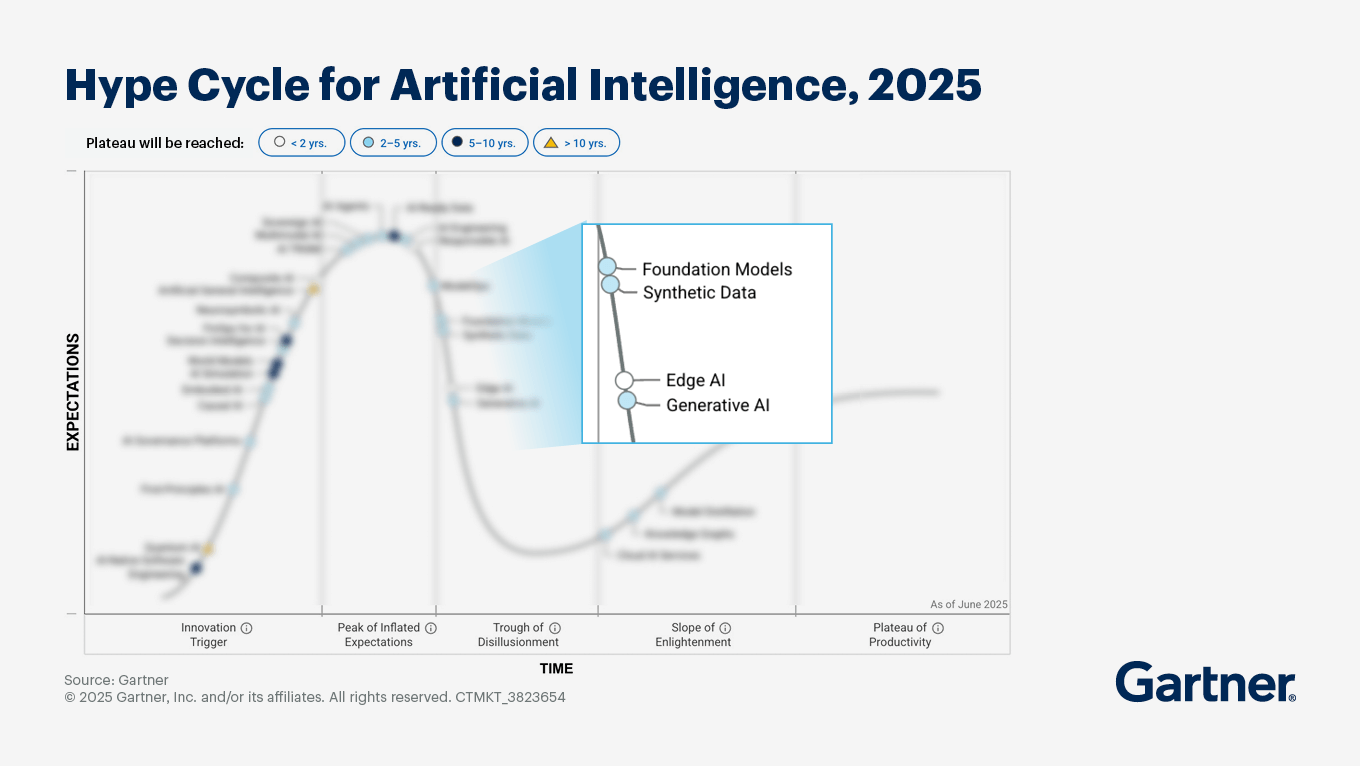What the 2025 Hype Cycle Tells Us About AI
Gartner’s Hype Cycle has long provided a reliable framework for understanding the trajectory of emerging technologies. In 2025, artificial intelligence presents a diverse picture. Various facets of the technology are distributed across different stages of the cycle, each revealing important insights about where innovation meets practicality.
(Image Courtesy of Gartner)
Generative AI, once the headline-grabbing innovation of recent years, is beginning its descent from the Peak of Inflated Expectations into the Trough of Disillusionment (Gartner, 2025). The initial excitement surrounding its creative potential is giving way to questions around real-world utility and sustainability. At the same time, AI agents and governance platforms continue to crest the peak, still driven by enthusiasm and promise. Meanwhile, more operationally grounded technologies like ModelOps, Causal AI, and knowledge graphs are making steady progress up the Slope of Enlightenment (eccenca, 2025), signaling a transition from experimentation to integration.
This diversity in placement reveals a broader truth. AI is no longer a singular movement. It is a spectrum of technologies, each evolving at its own pace and offering varying levels of maturity and value to business leaders.
Why Business Value Matters More Than Ever
While the hype once captivated audiences, the conversation around AI in 2025 is increasingly driven by return on investment. Business leaders are no longer content with surface-level innovation. They are seeking tangible outcomes.
(Image Courtesy of Epoch.ai)
The reality is that AI implementation, particularly in SaaS and enterprise contexts, is resource-intensive. The cost of compute power, infrastructure, talent, and system integration has grown significantly, and the overhead involved is often underestimated. The cost of training large AI models has been doubling roughly every year since 2016, with projections reaching billions by 2027 (Epoch.ai, 2024). When AI is added without a clear path to revenue, cost savings, or user engagement, it becomes a liability rather than a value-add.
For organizations that depend on efficiency and scalability, this is a critical concern. Metrics shared by Microsoft suggest potential high returns, but they also acknowledge wide variability depending on integration quality and business context. Effective ROI from AI depends on context, execution quality, and the ability to measure performance accurately. In short, the question businesses must ask today isn't “Can we use AI?” but “Will this AI investment truly pay off?”
AI for Value, Not Vanity
Too often, AI is still adopted for appearance rather than substance. Initiatives get greenlit to keep pace with competitors or capitalize on a trend, without a clear strategy for impact or integration. This approach leads to short-term visibility but long-term inefficiency.
As a software engineering agency actively deploying AI in more than half of our projects, we approach implementation with a strategic mindset. For us, AI isn’t about hype. It is about enhancing operations, solving problems, and driving real results. We target use cases like workflow automation, predictive analytics, and scalable personalization, where AI’s capabilities are aligned with business goals and measurable outcomes.
These aren’t speculative experiments. They are solutions designed with purpose, reflecting how AI should be approached as it matures beyond novelty.
AI’s Direction: Enlightenment Over Excitement
The industry is shifting. Organizations are becoming more thoughtful in how they evaluate, adopt, and scale AI technologies. We are seeing a notable transition away from flashy use cases toward foundational capabilities that improve reliability, security, and governance.
In 2025, investment is increasingly directed toward technologies that support long-term integration. ModelOps, explainability frameworks, data quality tools, and platform efficiency enhancements are all gaining momentum. This shift signals that the path to productivity isn’t paved with excitement alone. It is guided by strategy, measurement, and sustainable delivery.
As the Hype Cycle continues to evolve, we expect to see these foundational innovations move steadily toward the Plateau of Productivity, solidifying AI’s place not just in the future but in the now.
Final Thought: Hype Fades, Value Stays
Artificial intelligence is not a fleeting trend. It is a maturing force. But as it grows, the criteria for its adoption are evolving. ROI has emerged as the defining benchmark, separating short-lived experiments from strategic differentiators.
Gartner’s 2025 Hype Cycle reflects this new reality. While some technologies are still riding the wave of inflated expectations, others are proving their worth through consistent performance and business impact. The takeaway is clear. In an era where resources are precious and expectations are high, AI must deliver value to endure.
Let’s Talk About Your AI Potential
Wondering how AI could impact your SaaS product or technical roadmap? Contact us today to explore how strategic, ROI-focused AI solutions can unlock meaningful advantages for your organization.



